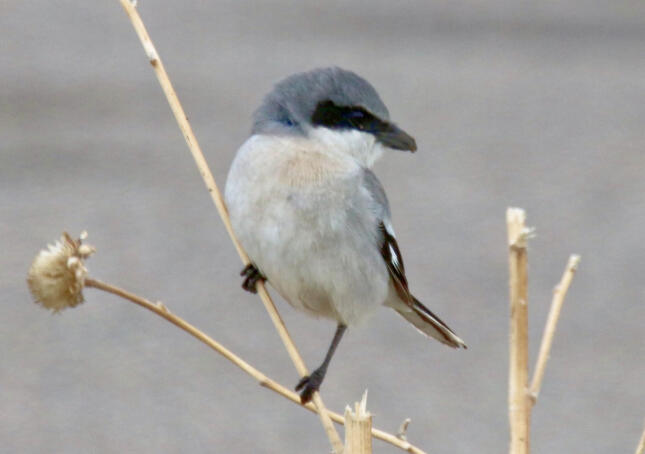
A Loggerhead Shrike scanning for prey at Las Vegas National Wildlife Refuge.
Avian Macabre: Flesh-Eating Songbirds and the Necrobiome
By Jay Cooney
Take a drive across New Mexico’s sweeping plains and you are likely to encounter a songbird whose name suits a slasher film. The butcherbird – or more formally, Loggerhead Shrike – is rather unassuming in appearance, small-bodied with a handsome dark mask, its predatory nature evident only in a sharply hooked bill. But spend enough time in shrike country and you might encounter the grisly remains of mice or lizards skewered onto thorns or barbed wire. The Loggerhead Shrike’s striking predatory behavior involves impaling small animals on sharp objects to cache for later consumption. While we mostly think about songbirds as benevolent seed-eaters, pursuers of insects at most, many species take advantage of opportunities to feed on other vertebrates. Exploring this lesser-known side of songbird diets draws us into the more macabre aspects of ecosystems that we tend to shy away from: the realm of decomposition that ecologists refer to as the ‘necrobiome.’
As the taxing cold of winter creeps in, bird feeding enthusiasts across the country put out fat to satisfy the cravings of backyard birds for animal-borne protein and calcium. Suet – rendered beef fat often mixed with nuts, seeds, and mealworms – offers a vital energy source for birds when insects are unavailable, yet its popularity is also linked to a more cryptic ecological context. Using camera traps, scientists have observed chickadees, nuthatches, and woodpeckers unexpectedly scavenging the carcasses of deer and other large mammals. Corvids like ravens, crows, and magpies frequently seek both dead and live flesh. Insect-eating songbirds are also drawn to the abundance of beetles and other arthropods nourished by carcasses, inspiring rewilding advocates to tout how having more large mammals on the landscape is a driver of insect diversity and thus bird diversity.
While scavengers carry a cultural association with rot and ruin, they are the architects of the communities of life that spring up around carcasses, which ecologists term necrobiomes. As environmental journalist Ben Goldfarb highlights in Crossings, carcasses comprise “self-contained ecosystems,” such that, “every wild death is also a beginning.” From Turkey Vultures to Black-billed Magpies, scavenging birds transform inert matter into soaring life. These interactions recycle nutrients and send waves of renewal across ecosystems: a 2023 study found that mountain lion kill sites enriched soil, fed hundreds of organisms, and promoted plant growth. Necrobiomes also serve as a vital buffer against disease for human communities. Research estimating the value of carrion removal found that vultures in Southern Africa alone contribute $93 million annually in sanitation services.
In our death-avoidant culture, decomposition fills us with unease, compelling us to opt for ‘Disneyfied’ portrayals of wild nature. As an Inuit shaman named Aua remarked to ethnologist Knud Rasmussen, “the greatest peril of life lies in the fact that human food consists entirely of souls.” Certainly, the ecological costs of our own consumption of industrially-reared animals and plants are often concealed to ease our conscience, but to the detriment of an ever-depleted biosphere. Facing the necrobiome, and our own embodiment in ecological cycles, might help us consume more honestly and re-orient towards practices of reciprocity with the planet that sustains and shelters us.
Jay Cooney is a Naturalist at Wild Birds Unlimited of Santa Fe

